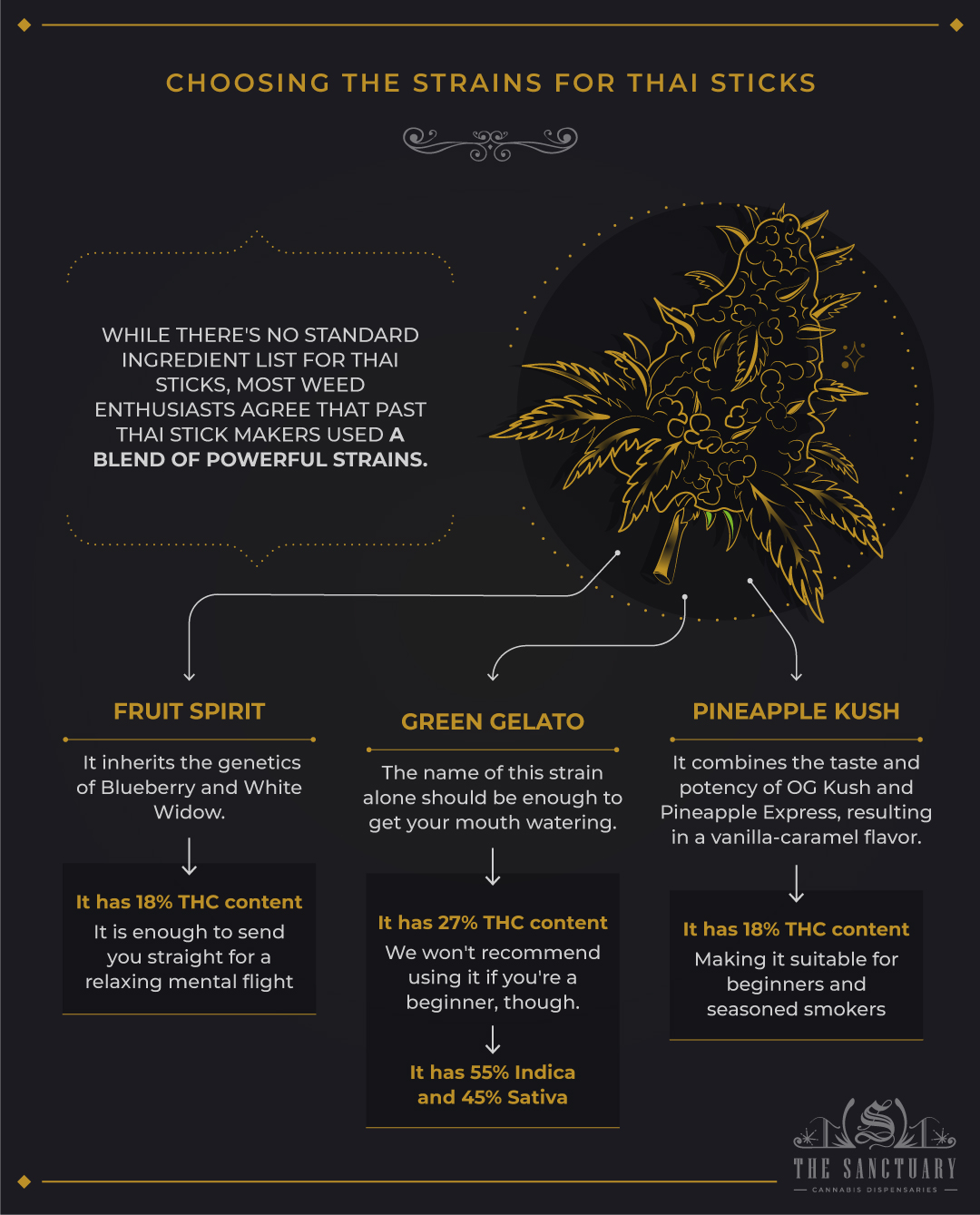Iftikhar Alam
Author
Reviewed by Cannabis Experts
Published on: October 2, 2023 | Updated on: September 11, 2024
If you take a quick look at the history of marijuana, you will not notice much change. Yes, we’ve found a way to convert weed into oils and edibles. But in most cases, we simply roll a joint and light it up — just like the ancient Chinese populations did.
A lot of variations that you see in weed products today come from experimentation. One of them is Thai sticks. As the name gives away, Thai sticks originated in Thailand. It’s speculated that American soldiers discovered Thai sticks amidst the Vietnam War and brought the experience back with them to the US.
There’s not much to learn about why Thai sticks became such hype during that time. Maybe they were dipped in opium or hash oil. Maybe, they had just the perfect blend of weed strains. We’ll never know.
But we do know how to make them today. So, let’s talk about that in detail.
Choosing the Strains for Thai Sticks

While there’s no standard ingredient list for Thai sticks, most weed enthusiasts agree that past Thai stick makers used a blend of powerful strains. Selecting the right strain makes all the difference in the final taste and potency of the Thai sticks. The following strains will make for a good choice:
Fruit Spirit
The key to making amazing Thai sticks is to select a strain that takes your taste buds for a fun ride. Fruit Spirit fits the bill in this regard since it inherits the genetics of Blueberry and White Widow.
It has an 18% THC content, which is enough to send you straight for a relaxing mental flight. Moreover, it has a sweet berry taste that lingers in the mouth after every puff.
Green Gelato
The name of this strain alone should be enough to get your mouth watering. Although it sounds like the perfect dessert, the strain also has 27% THC to give you the high you need.
We won’t recommend using it if you’re a beginner, though. With 55% Indica and 45% Sativa, the strain is quite balanced, but it’s more potent than what most beginners can handle.
Pineapple Kush
Pineapple Kush combines the taste and potency of OG Kush and Pineapple Express, resulting in a vanilla-caramel flavor. At 18%, it has a lower THC concentration than Green Gelato, making it suitable for beginners and seasoned smokers.
How to Make Thai Sticks: Step-by-Step Recipe
Whether you use one or more strains will depend on you. Either way, the base recipe remains the same.
Ingredients
- Buds from your chosen strain/s
- Hash oil
- Fan leaves of a weed plant
Materials
- Ziploc bag
- Parchment paper
- Hemp string
- Wooden skewer
Step 1: Choose the Buds
Once you’ve selected the strains you want to use, get enough flower buds to create a batch of Thai sticks. Pick fluffy buds, as they will be easier to work with. These buds also give a smooth yet intense effect.
Step 2: Prepare the Skewer
Use a brush to apply hash oil to the wooden skewer, ensuring it is coated completely. Now, stick the buds to the skewer to form a layer covering its whole length. Cover the whole skewer except its ends, just like you would prepare a kebab.
Step 3: Secure the Buds
Gently wrap the skewer with the hemp string. Make sure the weed buds are tightly secured to keep them in their place as you continue the rolling process. Tie the hemp string when you reach both ends.
Step 4: Cover the Skewer
Cover the skewer with parchment paper and keep it in the fridge for several days. Low temperatures help cure the weed and remove moisture, preventing rot. Refrigerating the skewer also makes the flavor stronger.
Step 5: Remove the String
After three days, take the parchment paper-covered skewer out of the fridge and remove the hemp string. At this point, the weed buds should be stuck to the skewer and not the string.
Cover the buds with a coat of hemp oil, increasing stickiness. Wrap the skewer with a fan leaf once you’re confident the buds are sticky enough.
Back in the day, Thai stick makers would cure the buds for three more days. However, not many people like to wait for that long today. Instead, you can simply coat the fan leaf with hemp oil to make it sticky and wrap it with another fan leaf. Repeat the step to cover the skewer with three fan leaves.
Step 6: Heat
Cover the skewer with parchment paper and heat it in a pan. Only heat the stick for a few seconds so the hash oil melts and coats all the layers inside.
Take the skewer off the pan or hot plate and let it cool. Remove the heated parchment paper and use hemp string to tightly secure the fan leaves onto the skewer. Wrap another piece of parchment paper (new, not the one you just removed) around the skewer. Put the wrapped-up stick in the fridge again.
Step 7: Cure
It’s time for the final curing now. Previously, people would bury the skewer underground for about 30 days. You can do the same if you have a backyard. Put the wrapped-up Thai stick in a plastic bag and bury it.
If you don’t have access to a year or ground for burial, you can cure the Thai stick in your refrigerator instead. Put the skewer in a Ziploc bag and vacuum seal it by removing all the air from the bag. Let it cure for at least 7 to 15 days in the fridge.
How to Smoke a Thai Stick?
After a long wait, it’s finally time to enjoy the fruit of your patience. Take the hemp string off the leaves and remove the skewer from the center.
Light up the Thai stick as you normally would light up a joint or blunt, and enjoy. Don’t use a gas stove or candle to light the Thai stick, as they can affect the weed’s flavor.
Conclusion
There’s no denying that making Thai sticks is a lengthy process requiring much patience and skill. But the final result is worth the wait. Select a strain of your liking, and don’t forget to use high-quality hash oil and fan leaves for the best result.
The content provided on this blog is for informational purposes only and does not constitute medical, legal, or professional advice. Cannabis use is subject to local laws and regulations, which vary widely by jurisdiction. Always consult with a healthcare professional before starting any new treatment or altering an existing treatment regimen. The authors and publishers of this blog are not responsible for any actions taken based on the information provided herein. Use cannabis responsibly and in accordance with applicable laws. This blog is intended for adults aged 21 and over. The Sanctuary Dispensaries D186, D187.








